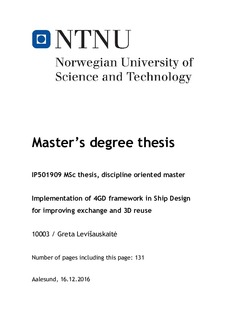| dc.contributor.advisor | Gaspar, Henrique M. | |
| dc.contributor.author | Levisauskaite, Greta | |
| dc.date.accessioned | 2017-10-24T13:19:49Z | |
| dc.date.available | 2017-10-24T13:19:49Z | |
| dc.date.issued | 2016 | |
| dc.identifier.uri | http://hdl.handle.net/11250/2461882 | |
| dc.description.abstract | Together with the development of technologies in maritime industry the needs and requirements of the customers are increasing. The necessity of fleet modernization and business process optimization is specifically high in the current market. Shipbuilding companies are seeking innovation and production cost reduction by exploring the opportunities and capabilities of data management and modelling software. However, due to loads of data in a vessel the ship building companies are struggling with the combination of efficient 3D modelling tools and keeping high control on the product's lifecycle. Therefore, it is a significant matter for the maritime companies to have a well-develop tools and approaches to efficiently manage vessel's lifecycle and boost the innovation. There are several software and approaches how to manage vast amount of data of which the most current one is 4th Generation Design (4GD) that manages the design and product data in one environment. | nb_NO |
| dc.description.abstract | The aim of this thesis is to apply and investigate the non-conventional approach (4GD) in ship design and evaluate if this is a beneficial approach in comparison with the conventional assembly Method. Due to wide range of the topic the scope of the thesis was limited to the investigation of a simplified Platform Supply Vessel (PSV) in context of Exchange improvement and 3D reuse facilitation from the 3D designer point of view. To achieve the main goal, a research method emphasizing particular issues in the design of a ship was established. The method was uniformly applied to the 4GD and traditional assembly approach to perform a comparative analysis. The main case study of the research comprises from the modelling and change processes of a PSV based on the challenges commonly met in the industry. | nb_NO |
| dc.description.abstract | The results of the case study are summarizing the user's experience working with 4GD and traditional assembly approach. A comparative analysis is performed on the two methods to emphasize the advantages and disadvantages one against each other. This kind of approach aids to see and discuss how the exchange and 3D reuse is improved and facilitated by the 4GD paradigm. Finally, the concluding remarks are completing the thesis by defining that 4GD has a great potential for innovation in ship design and is potentially beneficial for the shipbuilding companies. | nb_NO |
| dc.language.iso | eng | nb_NO |
| dc.rights | Attribution-NonCommercial-NoDerivatives 4.0 Internasjonal | * |
| dc.rights.uri | http://creativecommons.org/licenses/by-nc-nd/4.0/deed.no | * |
| dc.subject | 4GD | nb_NO |
| dc.subject | Ship design | nb_NO |
| dc.subject | Supply Vessel | nb_NO |
| dc.title | Implementation of 4GD framework in Ship Design for improving exchange and 3D reuse. | nb_NO |
| dc.type | Master thesis | nb_NO |
| dc.subject.nsi | VDP::Technology: 500::Marine technology: 580::Ship technology: 582 | nb_NO |
| dc.source.pagenumber | 131 | nb_NO |

